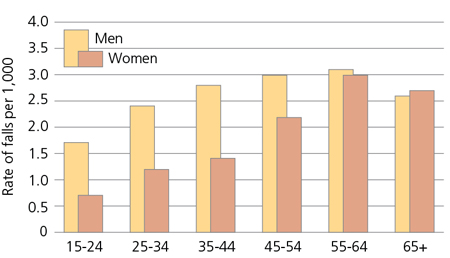Rate of falls per 1,000 workers, by age and sex, BC, 2008
In brief
- Serious injuries represent a minority of overall work-injuries in BC, yet account for over three-quarters of disability days paid and workers’ compensation claim costs.
- We used workers’ compensation claims data from WorkSafeBC to examine the rates of serious injury by demographic, work, and injury characteristics in BC.
- We identified several occupations with higher serious injury rates over the study period, including workers in manufacturing and utilities; trades, transport and construction; natural resources; and health. Rates were higher for men compared to women across high-risk occupations, with the exception of health, where women had three times the rate of men.
- The risk of serious injuries was also higher among specific age groups. For example, the middle age-groups (e.g. 35-44 years) had higher rates of strains/sprains and severe musculoskeletal injuries; whereas, older workers had higher rates of fractures and severe falls. Conversely, older workers had lower rates of contact injuries compared to younger workers.
- We also found distinct patterns of risk when examined separately for men and women. For example, the rate of fracture had less variation across age groups for men, whereas the rate for women increased steadily with age. There was also a greater association between age and severe fall-related injuries for women, with older women having substantially higher rates. Conversely, the rate of contact injuries for men declined consistently with increasing age; whereas, for women, the rates peaked in the 35-44 age group.
- Our findings provide evidence for the burden of serious injuries and a basis for future analytic research. Understanding the causes and consequences of serious injuries will inform the development of effective interventions to prevent serious injuries among workers.
Related publications
Characteristics of work-related fatal and hospitalised injuries not captured in workers’ compensation data
Journal article
Koehoorn M, Tamburic L, Xu F, Alamgir H, Demers P, McLeod C.
Occupational and Environmental Medicine. 2015; 72(6): 413-20.
Descriptive epidemiology of serious work-related injuries in British Columbia, Canada
Journal article
Fan J, McLeod C, Koehoorn M. PLoS ONE. 2012; 7(6): e38750.
Media release.

